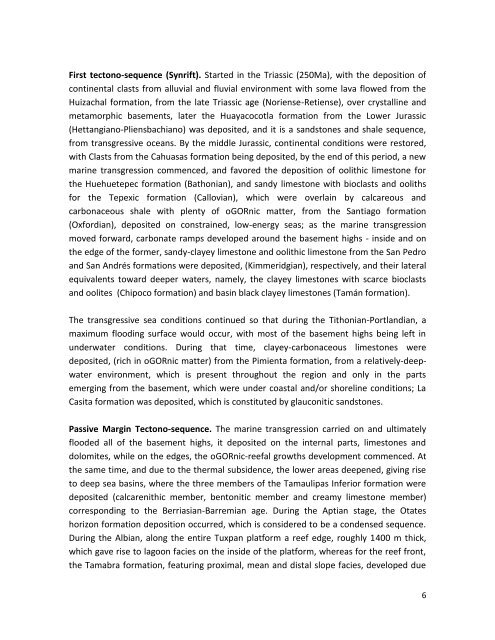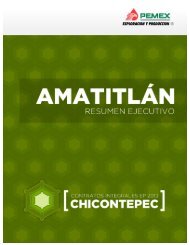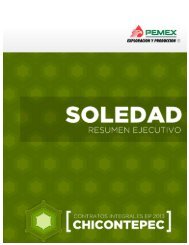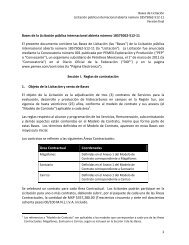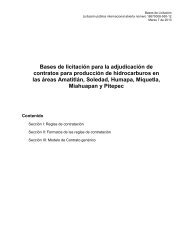Integrated Contract
Integrated Contract
Integrated Contract
Create successful ePaper yourself
Turn your PDF publications into a flip-book with our unique Google optimized e-Paper software.
First tectono-sequence (Synrift). Started in the Triassic (250Ma), with the deposition of<br />
continental clasts from alluvial and fluvial environment with some lava flowed from the<br />
Huizachal formation, from the late Triassic age (Noriense-Retiense), over crystalline and<br />
metamorphic basements, later the Huayacocotla formation from the Lower Jurassic<br />
(Hettangiano-Pliensbachiano) was deposited, and it is a sandstones and shale sequence,<br />
from transgressive oceans. By the middle Jurassic, continental conditions were restored,<br />
with Clasts from the Cahuasas formation being deposited, by the end of this period, a new<br />
marine transgression commenced, and favored the deposition of oolithic limestone for<br />
the Huehuetepec formation (Bathonian), and sandy limestone with bioclasts and ooliths<br />
for the Tepexic formation (Callovian), which were overlain by calcareous and<br />
carbonaceous shale with plenty of oGORnic matter, from the Santiago formation<br />
(Oxfordian), deposited on constrained, low-energy seas; as the marine transgression<br />
moved forward, carbonate ramps developed around the basement highs - inside and on<br />
the edge of the former, sandy-clayey limestone and oolithic limestone from the San Pedro<br />
and San Andrés formations were deposited, (Kimmeridgian), respectively, and their lateral<br />
equivalents toward deeper waters, namely, the clayey limestones with scarce bioclasts<br />
and oolites (Chipoco formation) and basin black clayey limestones (Tamán formation).<br />
The transgressive sea conditions continued so that during the Tithonian-Portlandian, a<br />
maximum flooding surface would occur, with most of the basement highs being left in<br />
underwater conditions. During that time, clayey-carbonaceous limestones were<br />
deposited, (rich in oGORnic matter) from the Pimienta formation, from a relatively-deep-<br />
water environment, which is present throughout the region and only in the parts<br />
emerging from the basement, which were under coastal and/or shoreline conditions; La<br />
Casita formation was deposited, which is constituted by glauconitic sandstones.<br />
Passive Margin Tectono-sequence. The marine transgression carried on and ultimately<br />
flooded all of the basement highs, it deposited on the internal parts, limestones and<br />
dolomites, while on the edges, the oGORnic-reefal growths development commenced. At<br />
the same time, and due to the thermal subsidence, the lower areas deepened, giving rise<br />
to deep sea basins, where the three members of the Tamaulipas Inferior formation were<br />
deposited (calcarenithic member, bentonitic member and creamy limestone member)<br />
corresponding to the Berriasian-Barremian age. During the Aptian stage, the Otates<br />
horizon formation deposition occurred, which is considered to be a condensed sequence.<br />
During the Albian, along the entire Tuxpan platform a reef edge, roughly 1400 m thick,<br />
which gave rise to lagoon facies on the inside of the platform, whereas for the reef front,<br />
the Tamabra formation, featuring proximal, mean and distal slope facies, developed due<br />
6


